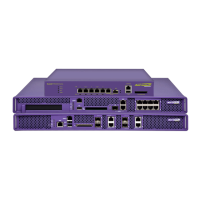Network Setup
Summit WM3000 Series Controller System Reference Guide86
1 Select Network from the main menu tree.
2 Refer to the following information to discern if configuration changes are warranted:
The Apply and Cancel buttons are greyed out within this screen, as there is no data to be configured
or saved.
DNS Servers
Displays the number of DNS Servers configured thus far for use with the controller.
For more information, see “Viewing Network IP Information” on page 87.
IP Routes
Displays the number of IP routes for routing packets to a defined destination. For
information on defining IP Routes, see “Configuring IP Forwarding” on page 90.
Additional Resolution
Entries
Displays the number of layer three (IP) address to layer two (MAC) address
mappings. For more information, see “Viewing Address Resolution” on page 93.
Controller Virtual
Interfaces
Displays the number of virtual interfaces (VLANs) defined thus far for the
controller. New VLANs can be defined or existing VLANs can be modified as
needed. For more information, see “Configuring Controller Virtual Interfaces” on
page 99.
Wireless LANs
Displays the number of WLANs currently defined on the controller. The controller
has 32 default WLANs. New WLANs can be added as needed, and their
descriptions, VLAN assignments and security schemes modified. By default all
WLANs are displayed with default values. The Summit WM3600 supports a
maximum of 32 WLANs. The Summit WM3700 supports a maximum of 256
WLANS. For more information, see “Viewing and Configuring Controller WLANs” on
page 109.
Mobile Units
Displays the number of MUs currently associated to (and interacting with) the
controller. The details of individual MUs can be displayed as needed. For more
information, see “Viewing Associated MU Details” on page 166.
Access Points
Displays the number of
Access Points
(APs) active on the controller. Access points
can be added or existing APs can have their VLAN assignments changed, their
descriptions modified and their current authentication and encryption schemes
modified. For more information, see “Viewing Access Point Information” on
page 176.
Radios
Displays the number of AP radios detected over the controller managed network.
Displayed with this information is the number of radios detected that have been
adopted by the controller. For more information, see “Configuring Access Point
Radios” on page 177.

